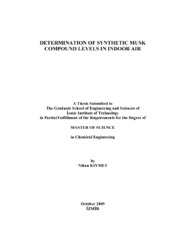Please use this identifier to cite or link to this item:
https://hdl.handle.net/11147/3015Full metadata record
| DC Field | Value | Language |
|---|---|---|
| dc.contributor.advisor | Sofuoğlu, Aysun | en |
| dc.contributor.author | Kıymet, Nihan | - |
| dc.date.accessioned | 2014-07-22T13:50:43Z | - |
| dc.date.available | 2014-07-22T13:50:43Z | - |
| dc.date.issued | 2009 | en |
| dc.identifier.uri | http://hdl.handle.net/11147/3015 | - |
| dc.description | Thesis (Master)--Izmir Institute of Technology, Chemical Engineering, Izmir, 2009 | en |
| dc.description | Includes bibliographical references (leaves: 47-50) | en |
| dc.description | Text in English; Abstract: Turkish an English | en |
| dc.description | ix, 50 leaves | en |
| dc.description.abstract | Synthetic musk compounds are one group of semivolatile organic compounds (SVOCs), and they are generally used as ingredients for odor in products such as detergent industry and cosmetics. Nowadays the increase in the use of synthetic musks caused increased in the production rate of these compounds. As a result they are detected in air, water, and aquatic biota. Like other SVOCs, they are classified as bioaccumulative, toxic and endocrine disrupting chemicals. In this study, 10 indoor air gas and particulate phase samples were collected from primary school classroom and woman sport center due to sensitivity of the group of people: children and woman in high activity. Particulate phase and gas phase synthetic musk compounds concentrations were determined. The synthetic musk compounds studied in this research were Galaxolide (HHCB), Tonalide (AHTN), Celestolide (ADBI), Traseolide (ATII), Phantolide (AHMI), Cashmeran (DPMI), Musk Ketone (MK), Musk Xylene (MX). The analyzed samples were showed the gas phase and particulate phase concentrations in primary school classroom were higher than sports center. All synthetic musk compounds were found in the gas phase samples in the primary school. Except musk ketone, the rest of the compounds were detected in the sports center. The gas phase concentration for classroom ranged from 267±56 (HHCB) to 0.12±0.2 ng /m3 (MK) while it varied from 144±60.6 (HHCB) to 0.08±0.1 ng/m3 (AHMI) for Sports Center. The order of the compounds in the samples for the sampling places showed differences. From the highest to lowest concentration order was HHCB>AHTN>ATII>DPMI>MX>ADBI>AHMI and HHCB> DPMI >AHTN>ATII>>MX>ADBI>AHMI>MK for sports center and classroom respectively. | en |
| dc.language.iso | en | en_US |
| dc.publisher | Izmir Institute of Technology | en |
| dc.rights | info:eu-repo/semantics/openAccess | en_US |
| dc.subject.lcc | TP983 .K99 2009 | en |
| dc.subject.lcsh | Perfumes, Synthetic | en |
| dc.title | Determination of synthetic musk compound levels in indoor air | en_US |
| dc.type | Master Thesis | en_US |
| dc.institutionauthor | Kıymet, Nihan | - |
| dc.department | Thesis (Master)--İzmir Institute of Technology, Chemical Engineering | en_US |
| dc.relation.publicationcategory | Tez | en_US |
| item.openairecristype | http://purl.org/coar/resource_type/c_18cf | - |
| item.grantfulltext | open | - |
| item.cerifentitytype | Publications | - |
| item.fulltext | With Fulltext | - |
| item.openairetype | Master Thesis | - |
| item.languageiso639-1 | en | - |
| Appears in Collections: | Master Degree / Yüksek Lisans Tezleri | |
Files in This Item:
| File | Description | Size | Format | |
|---|---|---|---|---|
| T000197.pdf | MasterThesis | 355.29 kB | Adobe PDF |  View/Open |
CORE Recommender
Page view(s)
242
checked on Nov 18, 2024
Download(s)
244
checked on Nov 18, 2024
Google ScholarTM
Check
Items in GCRIS Repository are protected by copyright, with all rights reserved, unless otherwise indicated.